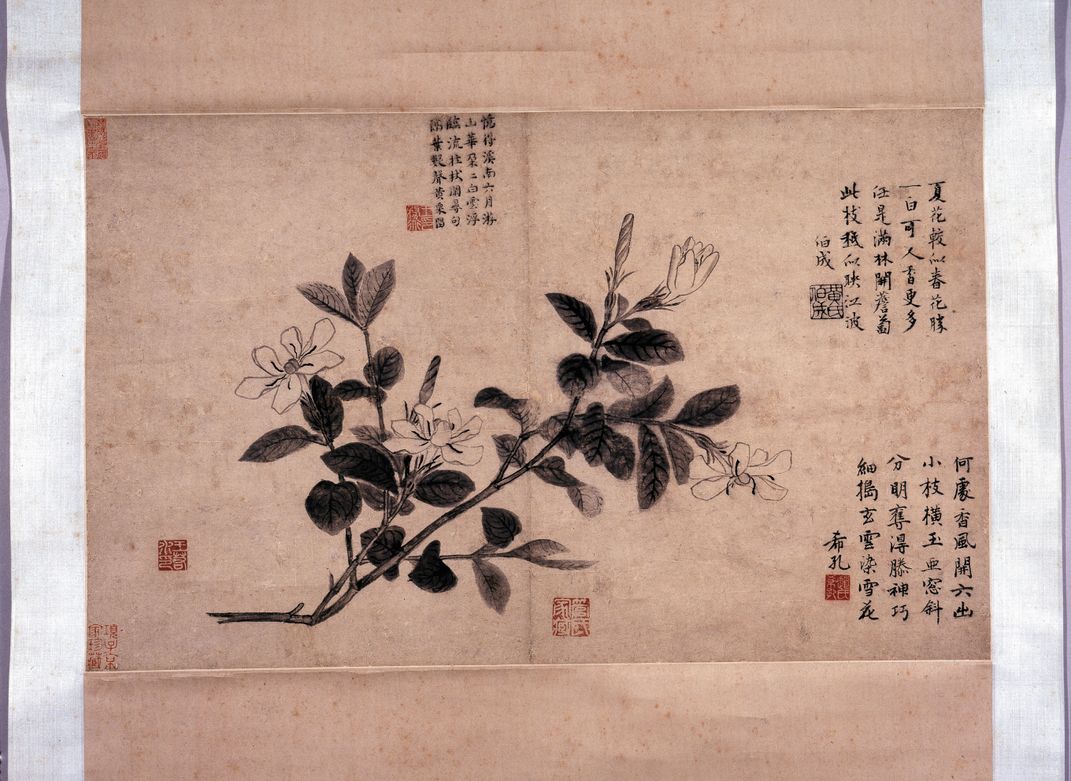A Scholar’s Detective Work Uncovers a Masterpiece at the Freer Gallery
Thought to be from a minor artist, this painting proved to be older and more significant than previously thought
/https://tf-cmsv2-smithsonianmag-media.s3.amazonaws.com/filer/4e/03/4e03b1c8-ee3d-4956-b52c-c2feee7c8c7c/jun14_k09_mall.jpg)
While visiting Shanghai in 1912, the American railroad-car magnate Charles Lang Freer purchased an ink painting depicting a branch of blooming hibiscus, a symbol of autumn. It bore the seal of the painter Wang Yuan, as well as the seals of his patron and three contemporary calligraphers, each of whom had penned a poem beside the flower.
Nine years later, Freer curator John E. Lodge delivered bad news: While Wang Yuan “was a man of considerable repute in his day”—he was, in fact, one of the most important painters of the Yuan dynasty (1271-1368)—“this can hardly be his.” And in 1958, curator James F. Cahill concurred, writing that while the painting was “closely related” to one attributed to Wang Yuan in the Palace Museum in Beijing, depicting a branch of flowering peony, a symbol of spring, the two “are probably works of the same artist (not, I think, Wang Yuan).”
The painting, actually a leaf from an album, was cataloged as a minor work by an unidentified artist of the Qing dynasty (1644-1912).
Our tale took a dramatic turn last year, when an esteemed curator at the Shanghai Museum of Art named Ling Lizhong came to the Freer and Sackler Galleries for six months on a fellowship. He ended up looking at some 400 Chinese paintings from the 15th, 16th and 17th centuries in collaboration with Stephen D. Allee, the museum’s associate curator of Chinese painting and calligraphy.

“We hit if off immediately,” says Allee, who in 1979 was among the first eight American graduate students allowed to study in the People’s Republic of China. “After reviewing the museum files for several days, Ling said to me, ‘I think we should look at this album leaf in your storage.’ It wasn’t even in his area of research.”
Ling recalls studying an image of the album leaf in the Freer’s database. “My instincts told me it was from the Yuan dynasty,” he says. “The paper, ink color, painting style and overall condition all hinted toward this.”
Allee picks up the story: “We went over that day to see it, and he immediately felt that the album leaf...was a genuine ink painting by Wang Yuan. There was no question in his mind.”
Despite Wang Yuan’s renown (which did not extend to having a dynasty named for him; the overlap in names is coincidental), genuine works by him are extremely rare—with “perhaps ten or fewer generally acknowledged,” Allee says.
With painstaking detective work, Ling validated his discovery. One of the calligraphers had a famous father, who is known to have died in 1345; that the calligrapher’s seal was in black ink, indicating the son was in mourning, rather than the traditional red seal paste, helped Ling date the seal to March 1347. Ling and Allee then compared the Freer hibiscus to the Palace Museum’s peony. Both were in the same style and had the seals of Wang Yuan, his patron and the three calligraphers.
Thus a supposedly minor work from the Qing dynasty turned out to be a masterpiece nearly 700 years old.
Then things really got exciting.
“I kept thinking I had seen this work before,” Allee says. “Five or six days later I had an aha moment. Years ago, I had gone over a little overview of the Chinese paintings in the British Museum.” He recalled seeing an ink painting of a branch of flowering gardenia, a symbol of summer: same style, same kind of paper, with the seals of Wang Yuan, his patron and the three writers.
“It just popped in my head,” Allee recalls. “I showed it to Ling, and we were overjoyed.” Allee visited the British Museum, studied the gardenia painting and confirmed his hunch. Now he and Ling were sure the Freer hibiscus was part of a Wang Yuan seasonal album.
But where is the flower for winter?
“I believe it would be a branch of plum blossom,” Ling says.
The search is on.
/https://tf-cmsv2-smithsonianmag-media.s3.amazonaws.com/accounts/headshot/wendy_new-1.jpeg)
/https://tf-cmsv2-smithsonianmag-media.s3.amazonaws.com/accounts/headshot/wendy_new-1.jpeg)